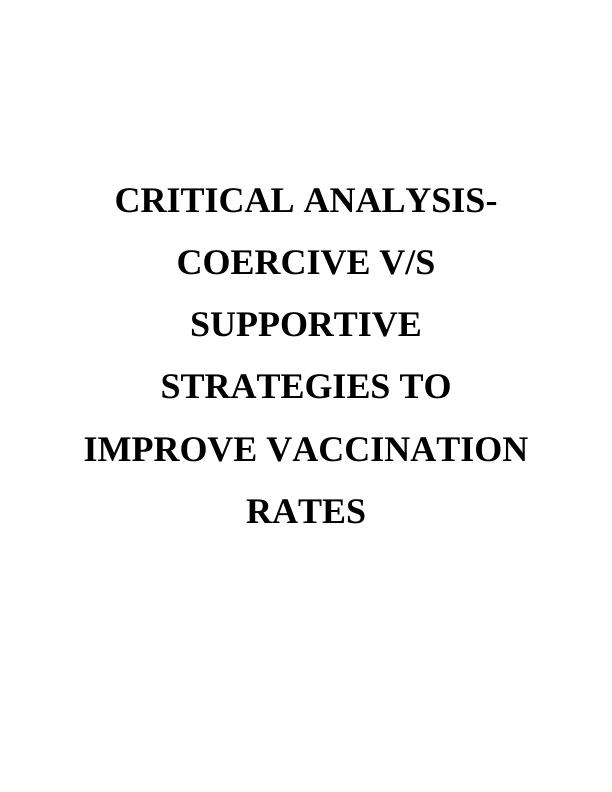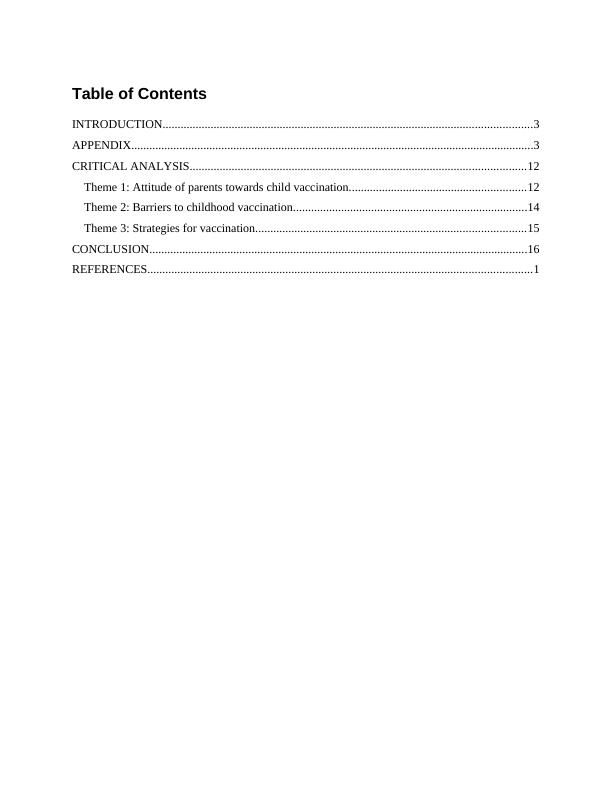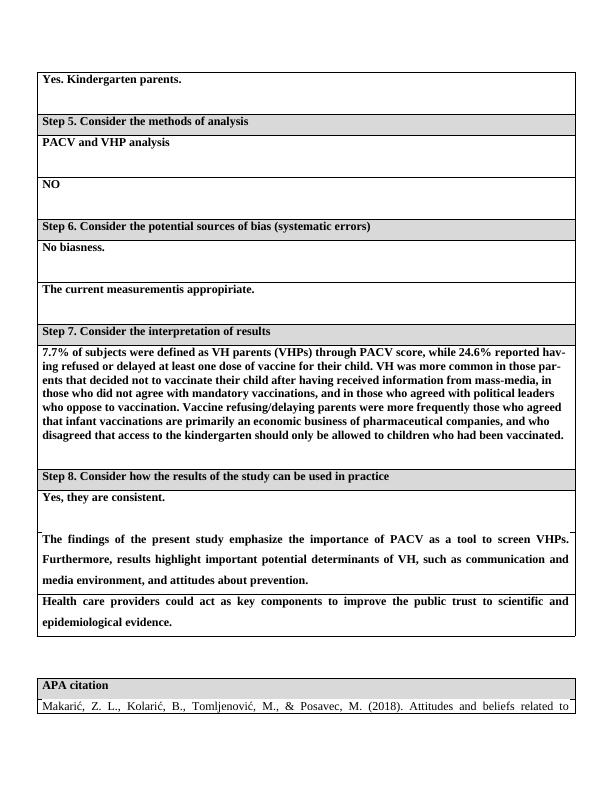Critical Analysis: Coercive vs Supportive Strategies to Improve Vaccination Rates
17 Pages4616 Words97 Views
Added on 2023-01-19
About This Document
This critical analysis explores the attitudes of parents towards child vaccination and examines the barriers and strategies for improving vaccination rates. Themes include parental attitudes, barriers, and strategies for vaccination.
Critical Analysis: Coercive vs Supportive Strategies to Improve Vaccination Rates
Added on 2023-01-19
ShareRelated Documents
CRITICAL ANALYSIS-
COERCIVE V/S
SUPPORTIVE
STRATEGIES TO
IMPROVE VACCINATION
RATES
COERCIVE V/S
SUPPORTIVE
STRATEGIES TO
IMPROVE VACCINATION
RATES

Table of Contents
INTRODUCTION...........................................................................................................................3
APPENDIX......................................................................................................................................3
CRITICAL ANALYSIS................................................................................................................12
Theme 1: Attitude of parents towards child vaccination...........................................................12
Theme 2: Barriers to childhood vaccination..............................................................................14
Theme 3: Strategies for vaccination..........................................................................................15
CONCLUSION..............................................................................................................................16
REFERENCES................................................................................................................................1
INTRODUCTION...........................................................................................................................3
APPENDIX......................................................................................................................................3
CRITICAL ANALYSIS................................................................................................................12
Theme 1: Attitude of parents towards child vaccination...........................................................12
Theme 2: Barriers to childhood vaccination..............................................................................14
Theme 3: Strategies for vaccination..........................................................................................15
CONCLUSION..............................................................................................................................16
REFERENCES................................................................................................................................1

INTRODUCTION
Vaccination amongst the children is an extremely critical issue and needs to be followed
by parents mandatorily so that a child can be protected from fighting diseases that they might
contact with in future. In this report a critical evaluation has been done on six articles that discuss
various aspects of the parent’s role in getting the child vaccinated. This report will also highlight
the various themes important for conducting the critical analysis effectively in highlighting the
importance of child vaccination.
APPENDIX
APA citation
Bianco, A., Mascaro, V., Zucco, R., & Pavia, M. (2019). Parent perspectives on childhood vaccination: How
to deal with vaccine hesitancy and refusal?. Vaccine, 37(7). 984-990.
Step 1. Consider the research hypothesis
What are parents perspectives on childhood vaccination.
Step 2. Consider the study design
Cross sectional study
Use of PACV survey
Step 3. Consider the outcome variable
Yes in quantitative manner.
Parental attitudes were measured using the Parent Attitudes about Childhood Vaccines (PACV)
survey, to screen for Vaccine Hesitancy (VH). In addition, selected factors have been grouped in three
categories (contextual, individual and group and vaccine/vaccination-specific influences), and were
explored as potential determinant of VH and vaccination refusal or delay
Step 4. Consider the exposure(s)
Parents
Vaccination amongst the children is an extremely critical issue and needs to be followed
by parents mandatorily so that a child can be protected from fighting diseases that they might
contact with in future. In this report a critical evaluation has been done on six articles that discuss
various aspects of the parent’s role in getting the child vaccinated. This report will also highlight
the various themes important for conducting the critical analysis effectively in highlighting the
importance of child vaccination.
APPENDIX
APA citation
Bianco, A., Mascaro, V., Zucco, R., & Pavia, M. (2019). Parent perspectives on childhood vaccination: How
to deal with vaccine hesitancy and refusal?. Vaccine, 37(7). 984-990.
Step 1. Consider the research hypothesis
What are parents perspectives on childhood vaccination.
Step 2. Consider the study design
Cross sectional study
Use of PACV survey
Step 3. Consider the outcome variable
Yes in quantitative manner.
Parental attitudes were measured using the Parent Attitudes about Childhood Vaccines (PACV)
survey, to screen for Vaccine Hesitancy (VH). In addition, selected factors have been grouped in three
categories (contextual, individual and group and vaccine/vaccination-specific influences), and were
explored as potential determinant of VH and vaccination refusal or delay
Step 4. Consider the exposure(s)
Parents

Yes. Kindergarten parents.
Step 5. Consider the methods of analysis
PACV and VHP analysis
NO
Step 6. Consider the potential sources of bias (systematic errors)
No biasness.
The current measurementis appropiriate.
Step 7. Consider the interpretation of results
7.7% of subjects were defined as VH parents (VHPs) through PACV score, while 24.6% reported hav-
ing refused or delayed at least one dose of vaccine for their child. VH was more common in those par-
ents that decided not to vaccinate their child after having received information from mass-media, in
those who did not agree with mandatory vaccinations, and in those who agreed with political leaders
who oppose to vaccination. Vaccine refusing/delaying parents were more frequently those who agreed
that infant vaccinations are primarily an economic business of pharmaceutical companies, and who
disagreed that access to the kindergarten should only be allowed to children who had been vaccinated.
Step 8. Consider how the results of the study can be used in practice
Yes, they are consistent.
The findings of the present study emphasize the importance of PACV as a tool to screen VHPs.
Furthermore, results highlight important potential determinants of VH, such as communication and
media environment, and attitudes about prevention.
Health care providers could act as key components to improve the public trust to scientific and
epidemiological evidence.
APA citation
Makarić, Z. L., Kolarić, B., Tomljenović, M., & Posavec, M. (2018). Attitudes and beliefs related to
Step 5. Consider the methods of analysis
PACV and VHP analysis
NO
Step 6. Consider the potential sources of bias (systematic errors)
No biasness.
The current measurementis appropiriate.
Step 7. Consider the interpretation of results
7.7% of subjects were defined as VH parents (VHPs) through PACV score, while 24.6% reported hav-
ing refused or delayed at least one dose of vaccine for their child. VH was more common in those par-
ents that decided not to vaccinate their child after having received information from mass-media, in
those who did not agree with mandatory vaccinations, and in those who agreed with political leaders
who oppose to vaccination. Vaccine refusing/delaying parents were more frequently those who agreed
that infant vaccinations are primarily an economic business of pharmaceutical companies, and who
disagreed that access to the kindergarten should only be allowed to children who had been vaccinated.
Step 8. Consider how the results of the study can be used in practice
Yes, they are consistent.
The findings of the present study emphasize the importance of PACV as a tool to screen VHPs.
Furthermore, results highlight important potential determinants of VH, such as communication and
media environment, and attitudes about prevention.
Health care providers could act as key components to improve the public trust to scientific and
epidemiological evidence.
APA citation
Makarić, Z. L., Kolarić, B., Tomljenović, M., & Posavec, M. (2018). Attitudes and beliefs related to

End of preview
Want to access all the pages? Upload your documents or become a member.
